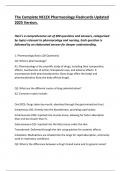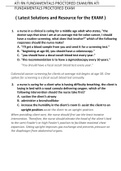The Complete NCLEX Pharmacology Flashcards Updated
2025 Version.
Here’s a comprehensive set of 200 questions and answers, categorized
by topics relevant to pharmacology and nursing. Each question is
followed by an elaborated answer for deeper understanding.
1. Pharmacology Basics (20 Questions)
Q1: What is pharmacology?
A1: Pharmacology is the scientific study of drugs, including their composition,
effects, mechanisms of action, therapeutic uses, and adverse effects. It
encompasses both pharmacodynamics (how drugs affect the body) and
pharmacokinetics (how the body affects drugs).
Q2: What are the different routes of drug administration?
A2: Common routes include:
Oral (PO): Drugs taken by mouth, absorbed through the gastrointestinal tract.
Intravenous (IV): Directly into the bloodstream, providing rapid action.
Intramuscular (IM): Injected into muscle tissue, allowing for faster absorption
than oral but slower than IV.
Subcutaneous (SC): Injected into the fatty tissue under the skin.
Transdermal: Delivered through the skin using patches for systemic effects.
Inhalation: Medications are inhaled into the lungs for rapid absorption, commonly
used in respiratory conditions.
Q3: What is the difference between a drug's brand name and its generic name?
,A3: The brand name is the proprietary name given by the manufacturer, often
trademarked, while the generic name is the chemical name or the common name
for the drug, recognized internationally. Generic drugs must contain the same
active ingredients as their brand-name counterparts.
Q4: What is pharmacokinetics?
A4: Pharmacokinetics is the study of how a drug moves through the body,
involving four primary processes: absorption (how the drug enters circulation),
distribution (how it spreads throughout the body), metabolism (how it's broken
down), and excretion (how it's eliminated).
Q5: What is pharmacodynamics?
A5: Pharmacodynamics examines how drugs interact with biological systems,
focusing on the drug's mechanism of action, effects, and the relationship between
drug concentration and response.
Q6: What is a therapeutic index?
A6: The therapeutic index is a measure of a drug's safety, calculated as the ratio
of the toxic dose to the effective dose. A higher therapeutic index indicates a
wider margin of safety, meaning there is a lower risk of toxicity at therapeutic
doses.
Q7: What are side effects?
A7: Side effects are unintended and often adverse reactions to a medication that
occur in addition to the desired therapeutic effects. They can vary from mild (e.g.,
nausea) to severe (e.g., organ damage), depending on the drug and individual
patient responses.
Q8: What are contraindications?
,A8: Contraindications are specific conditions or factors that serve as reasons to
withhold a certain medical treatment due to the harm it could cause the patient.
These can include allergies, existing health conditions, and potential drug
interactions.
Q9: What is the first-pass effect?
A9: The first-pass effect refers to the metabolism of a drug by the liver after it is
absorbed from the gastrointestinal tract but before it reaches systemic
circulation. This can significantly reduce the bioavailability of certain medications.
Q10: What is a loading dose?
A10: A loading dose is an initial higher dose of a medication given to rapidly
achieve a therapeutic level in the body, followed by maintenance doses. This is
particularly important for drugs with a long half-life.
Q11: How do you calculate drug dosages?
A11: Drug dosages are calculated based on various factors, including patient
weight (usually in kg), drug concentration, and the desired effect. Common
methods include using dimensional analysis or the formula: Dose = Desired Dose /
Stock Dose × Volume.
Q12: What are pharmacogenomics?
A12: Pharmacogenomics is the study of how an individual's genetic makeup
influences their response to drugs. It helps personalize medication therapy by
predicting efficacy and risk of adverse effects, enhancing patient outcomes.
Q13: What is drug tolerance?
, A13: Drug tolerance occurs when a patient requires increasingly higher doses of a
medication to achieve the same therapeutic effect due to prolonged use. This can
lead to dependency and potential overdose.
Q14: What is the role of the FDA in pharmacology?
A14: The FDA (Food and Drug Administration) is responsible for regulating the
safety and efficacy of drugs in the United States. It oversees the drug approval
process, ensuring that new medications are tested for safety before reaching the
market.
Q15: What is a drug interaction?
A15: A drug interaction occurs when one drug affects the pharmacological activity
of another, either enhancing or diminishing its effects. This can lead to
therapeutic failures or increased toxicity, necessitating careful monitoring.
Q16: What is the difference between efficacy and potency?
A16: Efficacy refers to the maximum effect a drug can produce, regardless of
dose, while potency indicates the amount of drug needed to produce a specific
effect. A more potent drug requires a lower dose to achieve the same effect as a
less potent drug.
Q17: What are controlled substances?
A17: Controlled substances are drugs that are regulated by law due to their
potential for abuse and addiction. They are classified into schedules (I-V) based on
their medical use and potential for dependency, with Schedule I being the most
restricted.
Q18: What is polypharmacy?





